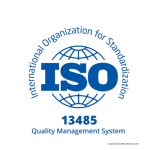
ISO 13485 is an internationally recognized standard that specifies requirements for a quality management system (QMS) specifically designed for organizations involved in the design, production, installation, and servicing of medical devices. The certification ensures that companies adhere to stringent regulatory requirements and best practices in the medical device industry.
Being ISO 13485 certified signifies that a company consistently meets customer and regulatory requirements, ensuring the safety and efficacy of medical devices. This certification is widely accepted across global markets and is often a prerequisite for businesses aiming to operate in the healthcare sector.
Understanding ISO 13485 Certification
ISO 13485 was developed by the International Organization for Standardization (ISO) to provide a framework for medical device manufacturers and associated service providers. The standard emphasizes risk management, quality control, and compliance with regulatory requirements.
ISO 13485 is based on ISO 9001, the general quality management system standard, but has additional requirements specific to the medical device industry. It focuses on key areas such as:
Regulatory compliance
Product safety and quality assurance
Risk management throughout the product lifecycle
Documented processes and traceability
Continuous improvement
Key Requirements of ISO 13485
To achieve ISO 13485 certification, an organization must comply with several key requirements, including:
1. Quality Management System (QMS)
Organizations must establish and maintain a documented QMS that ensures the consistent design, development, and production of medical devices that meet safety and regulatory requirements.
2. Risk Management
A structured risk management process must be in place to identify, assess, and mitigate risks associated with medical devices throughout their lifecycle.
3. Regulatory Compliance
Companies must comply with local and international regulatory requirements. This includes adherence to guidelines from authorities like the U.S. FDA (Food and Drug Administration), the European Medicines Agency (EMA), and other regulatory bodies.
4. Product Design and Development
ISO 13485 requires organizations to have strict controls over the design and development of medical devices, ensuring compliance with safety and performance standards.
5. Supplier and Outsourcing Control
Companies must establish quality controls for suppliers and outsourced processes to ensure that all components and services meet the required standards.
6. Documentation and Traceability
ISO 13485 emphasizes maintaining detailed documentation for every stage of production and development. This ensures traceability of materials and processes, which is critical for recalls and compliance audits.
7. Corrective and Preventive Actions (CAPA)
Organizations must implement CAPA processes to address any issues identified in audits, production, or customer feedback.
Benefits of ISO 13485 Certification
ISO 13485 certification offers multiple benefits to organizations in the medical device industry, including:
1. Regulatory and Market Compliance
The certification helps organizations comply with international regulatory standards, making it easier to enter global markets and gain customer trust.
2. Enhanced Product Quality and Safety
By following strict quality management principles, organizations can ensure that their medical devices are safe, effective, and meet regulatory standards.
3. Competitive Advantage
ISO 13485 certification is a mark of quality, helping companies gain a competitive edge in the medical device industry.
4. Risk Reduction
The focus on risk management and traceability helps reduce errors, product recalls, and compliance issues, ultimately improving operational efficiency.
5. Improved Customer Confidence
Clients and stakeholders trust ISO 13485-certified organizations more because they adhere to globally recognized quality standards.
Steps to Achieve ISO 13485 Certification
Organizations looking to obtain ISO 13485 certification must follow a structured process:
1. Gap Analysis
Perform a gap analysis to identify areas where the current quality management system falls short of ISO 13485 requirements.
2. Develop and Implement QMS
Establish and implement a quality management system (QMS) that aligns with the standard’s requirements.
3. Documentation and Training
Ensure all processes are documented, and employees receive proper training on ISO 13485 compliance.
4. Internal Audit
Conduct an internal audit to evaluate the effectiveness of the QMS and address any non-compliance issues.
5. Management Review
Company leadership should review the QMS and make necessary improvements before seeking external certification.
6. Certification Audit by a Notified Body
A third-party certification body conducts an audit to assess compliance. If successful, the organization receives ISO 13485 certification.
Who Needs ISO 13485 Certification?
ISO 13485 certification is essential for various organizations in the medical device industry, including:
Medical device manufacturers
Component suppliers
Medical software developers
Companies involved in the distribution and installation of medical devices
Contract manufacturers and service providers
Maintaining ISO 13485 Certification
After obtaining certification, organizations must:
Conduct regular internal audits.
Stay updated on regulatory changes.
Ensure continuous quality improvement.
Undergo surveillance audits by the certification body.
Conclusion
ISO 13485 certification is a critical benchmark for organizations in the medical device industry. It ensures compliance with international regulatory standards, enhances product quality, and improves customer confidence. By implementing a robust quality management system, organizations can not only achieve certification but also maintain long-term success in the highly regulated healthcare industry.
If your organization is looking to achieve ISO 13485 certification, start by conducting a gap analysis, developing a QMS, and engaging a certification body to guide you through the process. Achieving this certification can open doors to new markets, increase credibility, and ensure the safety of medical devices for global consumers.






Leave a Reply